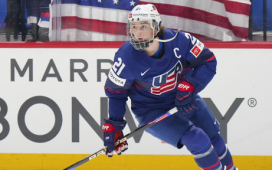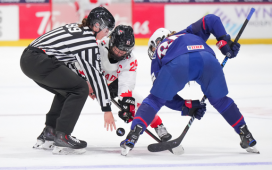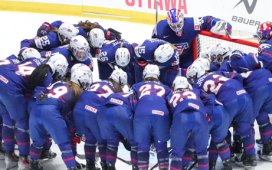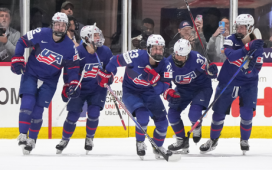The permutations and seedings continue to change, but the ideas floated most consistently among the NHL’s return-to-play scenarios in recent weeks are various versions of a 24-team tournament.
As Sportsnet’s Elliotte Friedman reported Wednesday, his sources currently indicate the NHL and NHL Players’ Association are working on a format in which:
– The top four seeds by points percentage in each conference receive byes but would participate in a three-game tournament to “get some action”
– The other 16 teams are seeded in brackets and play best-of-five series
– The eight winners of that bracket advance to a traditional (but bracketed) 16-team playoff with best-of-seven series
A 24-team format has produced plenty of online objections among fans and pundits alike. No straw-man argument here: just hop on the ole Twitter and see for yourself. And, sure, some of the conspiracy theories have weight to them, most notably the idea that a 24-team playoff brings not-very-good teams like Montreal and Chicago into the mix for highly transparent TV-market reasons. The NHL likes money.
I could get on my soapbox and say, “Who cares? It would be a lot of fun,” Or, “If you don’t like Montreal and Chicago making the playoffs, and they’re suuuuch bad teams, then it should be no problem beating them.” But I won’t. Not today, at least. The Detroit Red Wings, who have the lowest points percentage since the 1999-00 Atlanta Thrashers, beat the first-overall Boston Bruins twice this season. This ain’t the NBA. The NHL’s worst team has a Balboa’s chance against the best team on any given night. So I understand the anxiety over a shortened format getting a superior team ousted if it underperforms across a tiny sample.
But no matter what format the league settles on, be it 24, 22, 20 or even just the 16 teams currently holding playoff spots in the standings, it will be abnormal, unprecedented and, compared to whatever transpires in a regular, non-pandemic, 82-game season, unfair to at least a few markets. I thus find the idea of complaining about any format somewhat laughable during these crazy times…
…Especially when the NHL’s history of playoff formats is not some pristine Ark of the Covenant that shall never be disturbed. Allow me to take you on a brief tour of unfair-playoff-format history, post expansion.
Just because things have been silly in the past don’t mean they have to be silly today, of course. Two wrongs don’t make a right, as I’m sure people who read the tweet and not the article will reply on Twitter. But my point is: let’s not pretend for a second that the NHL playoffs have long been an institution of fairness.
1967-68: Expansion team gets automatic Cup final berth
When the NHL expanded from six to 12 teams, the Original Six stayed in one division, the East, while all six new teams were placed in the West. The format at the time had each division play its own bracket, meaning an expansion team would automatically win the West and play the East winner in the Cup final.
The standings breakdown by points percentage was comical in 1967-68:
EAST
Montreal, .635
NY Rangers, .608
Boston, .568
Chicago, .541
Toronto, .514
Detroit, .446
WEST
Philadelphia, .493
Los Angeles, .486
St. Louis, .473
Minnesota, .466
Pittsburgh, .453
Oakland, .318
The Blues would’ve been a sixth-place team in the East. Instead, they won the West bracket and reached the final, where they were swept by Montreal. Think the second-overall Rangers felt it was fair that they had to play fourth-overall Chicago in Round 1 and lost? The Blues ended up making the final three years in a row under this format, going 0-12 in the three series, including 1970, when Bobby Orr’s flying overtime goal ended it. Does anyone try to slap an asterisk on the most iconic goal in NHL history? Nope. People moved on.
1970-71: Bruins burned by Dryden
Boston finished with 121 points and the league’s best record, but the 1970-71 format pitted the No. 1 team in each division against the No. 3 team, and No. 2 played No. 4. So the reward for finishing second in your division actually trumped finishing first in Round 1. The Bruins ran into legendary rookie goalie Ken Dryden and lost the opening series in seven games.
1976-77: For shame, Smythe Division
The Smythe Division’s Minnesota North Stars and Chicago Black Hawks made the playoffs with point totals of 64 and 63. Add those up and they’d still finish five points behind the record-breaking Canadiens’ 132. The divisional playoff format automatically gave three teams from each division a playoff spot, meaning the Rangers, who had 72 points, missed the big dance. The following season, the NHL allowed the top six teams in each conference into the playoffs, regardless of division.
1987-88: Leafs make playoffs with 52 points
Toronto posted a sparkling 21-49-10 record and .325 points percentage…and made the playoffs as the Campbell Conference’s lowest seed. Meanwhile, in the East, the Rangers and Penguins missed with 82 and 81 points. They didn’t exactly get screwed given they played in a different conference, but it’s worth pointing out as an example of life being unfair.
1991-92: 65-point Whalers make playoffs over 79-point Islanders
The ’92 divisional brackets mirrored today’s regular format but without the crossover berths, meaning all four divisions were guaranteed four entries. That meant Hartford’s 65 points were good enough for a playoff spot as the fourth-place Adams Division team, while the Islanders, fifth in the Patrick with 79 points, stayed home.
1992-93 – Battle of Quebec in Round 1
It was a great series, but it was a shame to see it in Round 1. The Nordiques and Habs finished fourth and sixth, respectively, in the NHL’s overall standings, but because the playoffs were bracketed rather than sorted by conference seedings, they had to clash in the first round. The 1-to-8 seeding system debuted the following year.
1998-99 – Hurricanes, eighth in conference standings, get a No. 3 seed
Ah, the Southeast. As NHL expansion continued through the late 1990s, the league split teams into three divisions per conference, and the winner of each division received the top seeds. So Carolina, the eighth-best team in its own conference, “earned” a No. 3 seed and home ice in the first round. Its opponent, the Bruins, pulled out a series win regardless.
2006-07 – Sid’s first playoff appearance lasts one round
Sidney Crosby’s Pittsburgh Penguins reached the post-season during his sophomore year, in which he won the Hart and Art Ross Trophies. His Penguins and the Ottawa Senators tied for the third most points in the East with 105, but that darned Southeast messed up the seedings again, forcing the Pens and Sens to meet in Round 1. Crosby and Evgeni Malkin’s playoff debut lasted five games. Lame.
2011-12: Atlantic Division chaos
The Atlantic in 2005 produced four of the top five seeds in the Eastern Conference, as the Rangers, Penguins, Flyers and Devils finished with 109, 108, 103 and 102 points. The Florida Panthers won the Southeast – and a No. 3 seed – with 94 points. Pittsburgh and Philly, the No. 2 and 3 teams in the conference, had to play in Round 1. It was a zany, memorable series, but it should’ve happened later in the playoffs.
2016-17: The Big Three meet in Rounds 1 and 2
The Capitals, Penguins and Blue Jackets finished with 118, 111 and 108 points, good for first, second and fourth in the overall NHL standings. They all happened to play in the Metropolitan Division. The bracketed divisional playoff format, brought back in 2013-14 and still in place today, forced the league’s No. 2 and 4 teams to play in Round 1. The Penguins knocked off the Blue Jackets and advanced to Round 2, which gave us the league’s No. 1 and 2 teams matching up in Pittsburgh and Washington. So two of the league’s top four teams were done by the end of Round 2.
2017-18: Atlantic Division cannibalizes itself
The Lightning, Bruins and Leafs finished first, second and tied for third in the Eastern Conference in points. Boston and Toronto were forced to duke it out for seven games in Round 1 before Tampa took down Boston in Round 2. In the current format, if you don’t win your division, you’re punished severely.
Quite the pattern of bad breaks and unfair formats, right? It goes back decades. So go ahead and gripe about the 24-team proposal, but cool it on the asterisk talk. The Stanley Cup playoffs have never been a consistent model of pragmatism.
Want more in-depth features, analysis and opinions delivered right to your mailbox? Subscribe to The Hockey News magazine.








